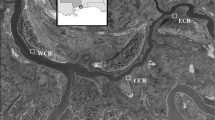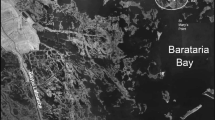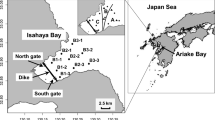Abstract
Distribution of squat lobsters of the genera Gastropthychus (one species), Uroptychus (1), Janetogalathea (1), Galacantha (1), Munidopsis (8), and Munida (7) in the Gulf of California, Mexico, was plotted vs. the localization of the Oxygen Minimum Zone (OMZ) using bottom projections of the 0.50, 0.25, 0.10, and 0.05 ml l−1 oxylines. Four fringes where oxygen concentrations were equal or lower than these concentrations were obtained, extending from the southern Gulf to about 28°–28°30′N. A total of 172 sampling locations with squat lobsters were plotted on four maps, one for each fringe, noting that with decreasing values of bottom oxygen (i.e., from 0.50 to 0.05 ml l−1) the number of locations with species included between the upper and lower boundaries of these fringes decreases as follows: 34% for 0.50, 25% for 0.25, 12% for 0.10, and 5% for 0.05 ml l−1. The upper and lower limits of the 0.05 ml l−1 fringe are recognised as threshold frontiers, acting as barriers between shallow and deep communities of squat lobsters in the area. The distribution of the localities where species have been collected with respect to the upper and lower boundaries of the 0.05 ml l−1 fringe clearly indicates a segregation pattern. Eight species of Munida (except M. perlata), and one each of Janetogalathea and Gastropthychus inhabit the shallow area, just above the OMZ core, with species of Munida generally found a rather long distance from this fringe. By contrast, species of Munidopsis, G. diomedeae and U. pubescens correspond to the deep area, i.e., below the OMZ core. It is suggested that the core of the OMZ in the Gulf of California serves as a vertical and latitudinal distribution filter, preventing species from freely migrating up and down or south and north.
Similar content being viewed by others
References
Baba K., Macpherson E., Poore G.C.B., Ahyong S.T., Bermudez A., Cabezas P., et al., Catalogue of squat lobsters of the World (Crustacea: Decapoda: Anomurafamilies Chirostylidae, Galatheidae and Kiwaidae, Zootaxa, 2008, 1905, 1–220
Hendrickx M.E., Ayon-Parente M., A new species of Munida Leach (Crustacea, Decapoda, Galatheidae) from off the west coast of Baja California, Mexico, Studies on Malacostraca: Lipke Bijdeley Holthuis Memorial Volume, Crust. Monogr., 2010, 14, 305–314
Hendrickx M.E., Decapod Crustaceans (Arthropoda: Crustacea: Decapoda) from deep water in the Mexican Pacific. List of species and material collected during the TALUD project [Crustáceos decápodos (Arthropoda: Crustacea: Decapoda) de aguas profundas del Pacífico mexicano: Lista de especies y material recolectado durante el proyecto TALUD], In: Zamorano P., Hendrickx M.E., Caso M. (Eds.), Biodiversity and communities of the continental slope of the Mexican Pacific, Secretary of Environment and Natural Resources (SEMARNAT), National Institute of Ecology (INE) [Biodiversidad y comunidades del talud continental del Pacífico mexicano, Secretaría del Medio Ambiente y Recursos Naturales (SEMARNAT), Instituto Nacional de Ecología (INE)], Mexico D.F., 2012 (in Spanish)
Diaz R.J., Rosenberg R., Marine benthic hypoxia: a review of its ecological effects and the behavioural responses of benthic macrofauna, Ocean. Mar. Biol. Ann. Rev., 1995, 33, 244–303
Levin L.A., Oxygen minimum zone benthos: adaptation and community response to hypoxia, Ocean. Mar. Biol. Ann. Rev., 2003, 41, 1–45
Gooday A.J., Bett B.J., Escobar E., Ingole B., Levin L.A., Neira C., et al., Habitat heterogeneity and its influence on benthic biodiversity in oxygen minimum zones, Mar. Ecol., 2010, 31, 125–147
Zamorano P., Hendrickx M.E., Distribution of Lucinoma heroica (Dall, 1901) in the minimum oxygen zone in the Gulf of California, Mexico, Mar. Biodivers. Rec., 2012, 5, 1–8
Rogers A.D., The role of oceanic oxygen minimum zones in generating biodiversity in the deep sea, Deep Sea Res., 2000, 47, 119–148
Hendrickx M.E., Serrano D., Impact of the minimum oxygen zone on the fishery corridors in the Mexican Pacific [Impacto de la zona de mínimo de oxígeno sobre los corredores pesqueros en el Pacífico mexicano], Interciencia, 2010, 35, 12–18 (in Spanish)
Hendrickx M.E., Oceanographic operations in deep water: past, present and the Mexican Pacific TALUD project challenges (1989–2009) [Operaciones oceanográficas en aguas profundas: los retos del pasado, del presente y del proyecto TALUD en el Pacífico mexicano (1989–2009)] In: Zamorano P., Hendrickx M.E., Caso M. (Eds.). Biodiversity and communities of the continental slope of the Mexican Pacific, Secretary of Environment and Natural Resources (SEMARNAT), National Institute of Ecology (INE) [Biodiversidad y comunidades del talud continental del Pacífico mexicano. P. Secretaría del Medio Ambiente y Recursos Naturales (SEMARNAT), Instituto Nacional de Ecología (INE)], Mexico D.F., 2012 (in Spanish)
Rosenberg R., Arntz W.E., Chumán de Flores E., Flores L.A., Carvajal G., Finger I., et al., Benthos biomass and oxygen deficiency in the upwelling system off Peru, J. Mar. Res., 1983, 41, 263–279
Levin L.A., Gage J.D., Relationships between oxygen, organic matter and the diversity of bathyal macrofauna, Deep-Sea Res. II, 1998, 45, 129–163
Hendrickx M.E., Occurrence of a continental slope decapod crustacean community along the edge of the minimum oxygen zone in the southeastern Gulf of California, Mexico, Belg. J. Zool., 2001, 131, 95–109
Levin L.A., Etter R.J., Rex M.A., Gooday A.J., Smith C.R., Pineda J., et al., Environmental influences on regional deep-sea species diversity, Ann. Rev. Ecol. Sys., 2001, 32, 51–93
Méndez N., Deep-water polychaetes (Annelida) from the southeastern Gulf of California, Mexico. Rev. Biol. Trop., 2006, 54, 773–785
Zamorano P., Hendrickx M.E., Toledano Granados A., Distribution and ecology of deep water mollusks from the continental slope, southeastern Gulf of California, Mexico, Mar. Biol., 2006, 150, 883–892
Helly J.J., Levin L.A., Global distribution of naturally occurring marine hypoxia on continental margins, Deep-Sea Res. I., 2004, 51, 1159–1168
Serrano D., Hendrickx M.E., Under the oxygen minimum zone [Debajo de la zona del mínimo de oxígeno], Invest. Cienc., 2011, 417, 13–15 (in Spanish)
Hendrickx M.E., Ayón-Parente M., Serrano D., Additional record of Janetogalathea californiensis (Benedict, 1901) (Anomura: Galatheidae) from the central Gulf of California, Mexico with notes on its distribution, Hidrobiologica, 2011, 21, 89–94
Alvarez-Borrego S., Physical, Chemical, and Biological Oceanography of the Gulf of California, In: Brusca R.C. (Ed.), The Gulf of California. Biodiversity and Conservation. Arizona-Sonora Desert Museum Studies in Natural History, ASDM Press and University of Arizona Press, 2010
Massin C., Hendrickx M.E., A new species of deepwater Holothuroidea (Echinodermata) of the genus Synallactes from off western Mexico, Sci. Mar., 2010, 74, 599–603
Hendrickx M.E., Mah C., Zárate Montes C.M., Deep-water Asteroidea (Echinodermata) collected during the TALUD cruises in the Gulf of California, Mexico. Rev. Mex. Biod., 2011, 82, 798–824
Méndez N., Polychaetes (Annelida, Polychaeta) from the southeastern slope of the Gulf of California and their relationship with some environmental variables [Poliquetos (Annelida, Polychaeta) del talud continental suroriental del golfo de California y su relación con algunas variables ambientales], In: Zamorano P., Hendrickx M.E., Caso M. (Eds.), Biodiversity and communities of the continental slope of the Mexican Pacific, Secretary of Environment and Natural Resources (SEMARNAT), National Institute of Ecology (INE) [Biodiversidad y comunidades del talud continental del Pacífico mexicano, Secretaría del Medio Ambiente y Recursos Naturales (SEMARNAT), Instituto Nacional de Ecología (INE)], Mexico D.F., 2012 (in Spanish)
Faxon W., Reports on the dredging operations off the west coast of Central America to the Galapagos, to the west coast of Mexico, and the Gulf of California, in charge of Alexander Agassiz, carried on by the U.S. Fish Commission steamer “Albatross”, during 1891, Lieut. Commander Z.L. Tanner, U.S.N. commanding. VI. Preliminary descriptions of new species of Crustacea, Bull. Mus. Comp. Zool. Harvard Coll., 1893, 24, 149–220
Faxon W., Reports on an exploration off the west coast of Mexico, Central and South America, and off the Galapagos Islands, in charge of Alexander Agassiz, carried on by the U.S. Fish Commission steamer “Albatross”, during 1891, lieut. Commander Z.L. Tanner, U.S.N., commanding. XV. The stalkeyed Crustacea, Mem. Mus. Comp. Zool. Harvard Coll., 1895, 18, 1–292
Benedict J.E., Description of a new genus and forty six new species of crustaceans of the family Galatheidae, with a list of the known marine species, Proc. U.S. Nat. Mus., 1902, 26, 243–334
Hendrickx M.E., The genus Munida Leach (Crustacea, Decapoda, Galatheidae) in the eastern tropical Pacific, with description of two new species, Bull. Inst. Royal Sci. Nat. Belgique, 2000, 70, 163–192
Hendrickx M.E., Geographic and bathymetric distributions of species of Munidopsis (Crustacea: Decapoda: Galathaeidae) in the SE Gulf of California, Mexico, In: Hendrickx M.E. (Ed.). Contributions to the Study of East Pacific Crustaceans 2 [Contribuciones al Estudio de los Crustáceos del Pacífico Este 2], Marine Sciences and Limnology Institute, UNAM, Mexico D.F., 2003
Hendrickx M.E., Second capture of Odontozona foresti Hendrickx, 2002 (Stenopodidea) and Munida bapensis Hendrickx, 2000 (Galatheoidea) in western Mexico, In: Hendrickx M.E. (Ed.). Contributions to the Study of East Pacific Crustaceans. [Contribuciones al Estudio de los Crustáceos del Pacífico Este], Marine Sciences and Limnology Institute, UNAM, Mexico D.F., 2008
Baba K., Deep-sea Chirostylid and Galatheid Crustaceans (Decapoda: Anomura) from the Indo-Pacific, with a list of species. Scientific Results of the Danish Deep-Sea Expedition Round the World 1950–52, Galathea Rep., 2005, 20, 1–317
Hendrickx M.E., Squat lobsters (Crustacea: Decapoda: Galatheoidea and Chirostyloidea) collected during the TALUD XIV cruise in the Gulf of California, Mexico, and rediscovery of Gastroptychus perarmatus (Haig, 1968) in the eastern Pacific, Zootaxa, 2012, 3418, 28–40
Hendrickx M.E., Salgado Barragán J., The stomatopods (Crustacea: Hoplocarida) from the Mexican Pacific [Los estomatópodos (Crustacea: Hoplocarida) del Pacífico mexicano], Publ. Esp. Inst. Cienc. Mar Limnol., UNAM, 1991, 10, 1–200
NOAA, National Geophysical Data Center (NGDC), National Oceanographic Atmospheric Administration, www.ngdc.noaa.gob/mgg/bathymetry, 2012
Hendrickx M.E., Ayón-Parente M., Rediscovery of Uroptychus pubescens Faxon, 1893 (Decapoda: Anomura: Chirostylidae) in the southern Gulf of California, Pacific coast of Mexico, Crustaceana, 2011, 84, 1411–1420
Hendrickx M.E., Squat lobsters (Crustacea: Decapoda: Galatheoidea and Chyrostyloidea) collected during the TALUD XIV cruise in the Gulf of California, Mexico, and rediscovery of Gastropthychus perarmatus (Haig, 1968) in the eastern Pacific, Zootaxa, 2012, 3418, 28–40
Luke S.R., Catalog of the benthic invertebrate collections. I. Decapod Crustacea and Stomatopoda, University of California, SIO Ref. Ser., 1977
Moran D.A., Dittel A.I., Anomuran and Brachyuran crabs of Costa Rica: annotated list of species, Rev. Biol. Trop., 1993, 49, 599–617
Kamykowski D., Zentara S.-J., Hypoxia in the world ocean as recorded in the historical data set, Deep-Sea Res., 1990, 37, 1861–1874
Gage J.D., Tyler P.A., Deep-sea biology: a natural history of organisms at the deep-sea floor, Cambridge University Press, United Kingdom, 1992
Sanders N.K., Childress J.J., Adaptations to the deep-sea oxygen minimum layer: oxygen binding by the hemocyanin of the bathypelagic mysid, Gnathophausia ingens Dorhn, Biol. Bull., 1990, 178, 286–294
Maske H., Cajal Medrano R., Trasviña Castro A., Jiménez Mercado A., Almeda Jauregui C.O., Gaxiola Castro G., et al., Inorganic carbon and biological oceanography above a shallow oxygen minimum in the entrance to the Gulf of California in the Mexican Pacific, Limnol. Oceanog., 2010, 55, 481–491
Paulmier A., Ruiz-Pino D., Garçon V., CO2 maximum in the oxygen minimum zone (OMZ), Biogeosciences, 2011, 8, 239–252
Escribano R., Zooplankton interactions with the oxygen minimum zone in the eastern south Pacific. Gayana, 2006, 70, 19–21
Ekau K., Auel H., Portner H.-O., Gilbert D., Impacts of hypoxia on the structure and processes in pelagic communities (zooplankton, macro-invertebrates and fish), Biogeosciences, 2010, 7, 1669–1699
Wishner K., Levin L., Gowing M., Mullineaux L., Involvement of the oxygen-minimum in benthic zonation on a deep seamount, Nature London, 1990, 346, 57–59
Hendrickx M.E., Size and abundance of deep water shrimps on the continental slope of the SE Gulf of California, Mexico, In: Hendrickx M.E. (Ed.), Contributions to the Study of East Pacific Crustaceans 2. [Contribuciones al Estudio de los Crustáceos del Pacífico Este 2], Marine Sciences and Limnology Institute, UNAM, Mexico D.F., 2003
Parker R.H., Zoogeography and ecology of some macro-invertebrates, particularly mollusks, in the Gulf of California and the continental slope off Mexico, Vidensk. Medd. Dansk naturh. Foren., 1963, 126, 1–178
Lavin M.F., Durazo R., Palacios E., Argote M.L., Carrillo L., Lagrangian observations of the circulation in the northern Gulf of California, J. Phys. Ocean., 1997, 27, 2298–2305
Mileikovsky S.A., Types of larval development in marine botom invertebrates, their distribution and ecological significance: a re-evaluation, Mar. Biol., 1971, 10, 193–213
van Dover C.L., Williams A.B., Egg size in squat lobsters (Galatheoidea): Constraint and freedom, In: Wenner A., Kuris A. (Eds.), Crustacean egg production, A.A. Balkema, Rotterdam, 1991
Williamson D.I., Larval morphology and diversity, In: Abele L.G. (Ed.), The Biology of Crustacea 2, Academic Press, Inc., 1982
Schnabel K.E., Cabezas P., McCallum A., Macpherson E., Ahyong S.T., Baba K., World-wide distribution patterns of squat lobsters, In: Poore G.C.B., Ahyong S.T., Taylor J. (Eds.), The Biology of Squat Lobsters, CSIRO Publishing, 2011
Author information
Authors and Affiliations
Corresponding author
About this article
Cite this article
Hendrickx, M.E., Serrano, D. Effects of the oxygen minimum zone on squat lobster distributions in the Gulf of California, Mexico. cent.eur.j.biol. 9, 92–103 (2014). https://doi.org/10.2478/s11535-013-0165-6
Received:
Accepted:
Published:
Issue Date:
DOI: https://doi.org/10.2478/s11535-013-0165-6




